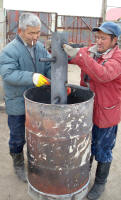I recently did a second and third burn in my biochar kiln, tweaking each time. The story is best told in pictures:
Upon detailed inspection, the April test burn actually gave good results. Four white buckets are completely charred material, two orange buckets incomplete, one mixed and one of material from the surrounding fire.
Completely charred wood from retort, and the incompletely charred – only a small amount, and generally from the bottom of the barrel, perhaps due to a lower temperature there.
Preparing for burn #2, using smaller wood and some changes to the kiln.
Added a layer of firebrick at the base. Ideally, it should enclose the whole chamber, but that would take a lot of actual masonry.
More air inlets, allowing air into all four corners.
The ‘chimney’ is formed by the blocks themselves.
Smaller wood scraps for burn #2.
Opening the kiln after burn #2.
As before, the material at the bottom of the barrel (top, when inverted like this) is less charred, but everything above (below) it is completely charred
Much of the sticks that look brownish on the outside are actually completely charred black on the inside
Got the fire real hot this time, you can clearly hear the “whoosh” of the pyrolysis gasses from the barrel joining the fire
Sifting/crushing/sorting the result. Some 1/2″-minus has direct uses. The rest will soak in nutrients to charge it, then goes through the chipper-shredder to make “charged fines” – biochar fertilizer.
 As a followup to my last biochar post, i was sent the following document from Karl Frogner of
As a followup to my last biochar post, i was sent the following document from Karl Frogner of 